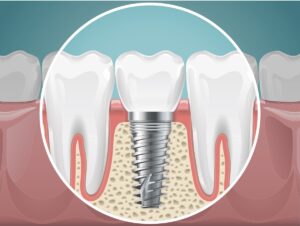A dental implant can be used to replace a missing tooth. An implant is a very strong artificial (prosthetic) tooth that replaces the entire missing tooth, including the root. This fixture in the mouth has become a predictable and long-lasting treatment option for replacing missing teeth.
The Implant

This illustration shows the concept of a Dental Implant, in this case, replacing a single missing tooth.
The base of the implant is a titanium screw, which is surgically placed into the bone in the space from where the original tooth was lost. The implant screw replaces the root of the missing tooth.
Once the bone around the implant has healed, an implant-retained crown is placed over the top, resembling the top part of the missing tooth.
Implants can also be used to anchor bridges and dentures, to replace multiple missing teeth.
Any surgery or invasive procedure carries risks, about which you will be informed before the treatment is provided. The type and number of surgeries required will depend on the case, and healing times will also vary.
Dental Implant Procedure: Surgical Phase
Dr Teo will assess the site’s suitability for implant placement. She will then either place the implant or, where appropriate, refer you to a specialist for the surgical part of your implant treatment. It is critical that the dental implant screw is placed in the ideal position within the jaw. This requires consultation and planning between the specialist (if necessary) and Dr Teo, who attaches the final crown to the implant.
Dental Implant Procedure: Crown Placement
Dr Teo will fix a customised implant crown onto your dental implant once healing is complete. You may be referred to one of our specialists, if required, for more involved implant restorations such as implant-retained bridges or over-dentures.
Care of Your Dental Implant
It is important to keep your dental implant free of plaque to prevent gum disease from developing around the implant ‘root’. In most cases, implant care is similar to the care of your natural teeth and involves daily brushing and flossing.
The implant crown will generally be covered in dental porcelain (supported by underlying metal). The porcelain allows it to be matched to the colour of your nearby teeth. However, porcelain is brittle, just like enamel, so it is possible for porcelain to chip. In most cases, the crown can be repaired.
If you have a history of grinding your teeth, Dr Teo may recommend wearing a night guard (occlusal splint) to protect your implant from fracture.
Dental implants have a very high rate of success and generally last for many years. You can learn more about dental implants by reading our dental implant articles.
